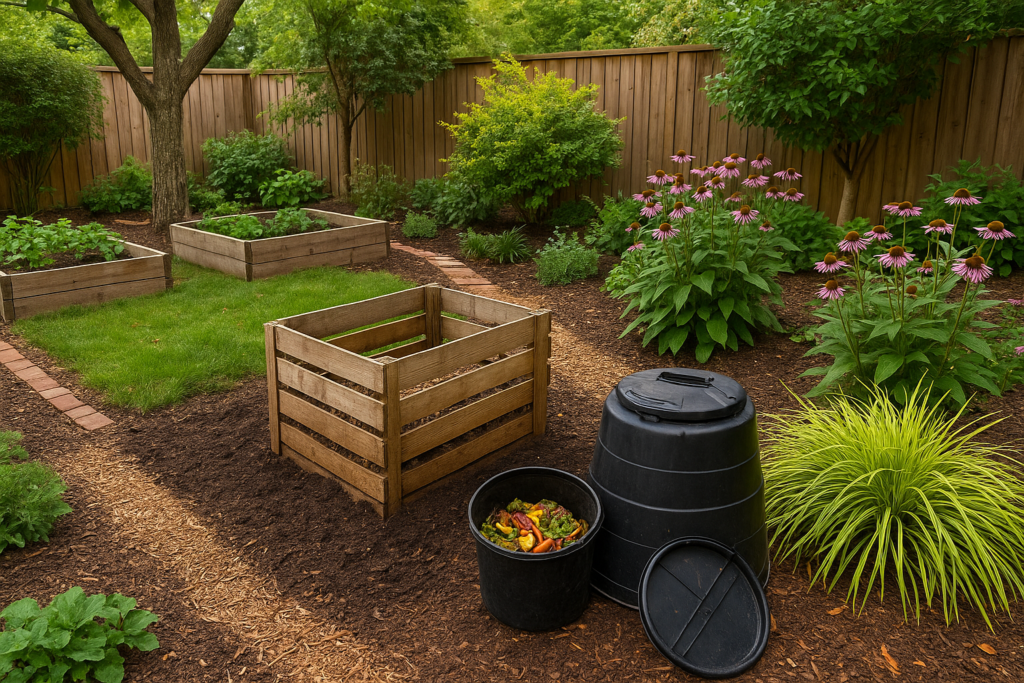Creating a sustainable and beautiful outdoor space requires more than just planting flowers and mowing the lawn. Bright View Landscape emphasizes the importance of integrating green waste reduction practices into every garden design. By rethinking how we handle garden by-products—like grass clippings, leaves, and plant trimmings—we can reduce landfill waste, cut greenhouse gas emissions, and enrich our gardens naturally.
Understanding Garden Waste and Its Impact
Garden waste includes the organic by-products of lawn maintenance and landscaping. While it might seem harmless, dumping it in landfills contributes to methane emissions, a potent greenhouse gas. By adopting eco-conscious approaches to garden waste management, you can transform these materials into valuable resources for your landscape.
Benefits of Composting at Home
Composting turns organic waste into nutrient-rich soil conditioner that improves texture, aeration, and water retention. It also supports beneficial microorganisms, reducing the need for synthetic fertilizers.
How to start composting:
- Choose a dry, shady spot near water.
- Layer greens (grass clippings, food scraps) and browns (dry leaves, branches).
- Mix layers regularly to speed decomposition.
- Keep compost moist but not waterlogged.
A good mix is about one-third green materials and two-thirds browns for optimal results. For larger properties, using a material handling trolley can make transporting compost more efficient.
Mulching: A Dual-Purpose Solution
Mulching is one of the easiest ways to recycle garden waste while improving plant health. It retains soil moisture, suppresses weeds, and enriches the soil as it decomposes.
Common mulch materials from garden waste:
- Shredded leaves
- Grass clippings (spread thin to prevent matting)
- Wood chips and bark
When designing a sustainable yard, incorporate durable hardscaping like kerb stone to create tidy mulch borders and define planting areas.
Grasscycling for a Healthier Lawn
Grasscycling—leaving clippings on the lawn after mowing—reduces waste and returns nutrients like nitrogen and potassium back into the soil.
Grasscycling tips:
- Mow when grass is dry.
- Keep mower blades sharp.
- Cut no more than one-third of grass height at a time.
This technique also reduces municipal waste collection needs and lowers your garden’s carbon footprint.
Sustainable Garden Design Strategies
Smart design choices can significantly reduce green waste production:
- Plant Selection: Choose drought-tolerant and native plants that require less maintenance and water.
- Perennial Planting: Reduces the need for seasonal replanting.
- Grouping by Needs: Plant species with similar sunlight and watering requirements together for efficiency.
For inspiration on integrating sustainability with aesthetics, see Bright View Landscape and Pollinator-Friendly Ideas and Bright View Landscape | Designing Pollinator-Friendly Gardens.
Reusing Plant Cuttings Creatively
Instead of discarding trimmings:
- Add them to compost.
- Use them for green mulch.
- Propagate new plants.
- Make nutrient-rich “plant tea” for watering.
Propagation not only saves money but also fosters a cycle of reuse that benefits your garden ecosystem.
Natural Pest Control to Reduce Waste
Chemical pesticides often lead to plant damage and additional waste. Natural pest control promotes garden balance without harmful residues.
Methods include:
- Introducing beneficial insects like ladybugs.
- Companion planting (e.g., marigolds to repel nematodes).
- Using neem oil or diatomaceous earth.
Integrating Composting into Landscape Design
A sustainable garden thrives when composting is built into its maintenance routine. By combining composting with smart plant choices and waste reduction methods, you create a resilient ecosystem. Learn more with Bright View Landscape With Composting Integration.
Sustainable Design Beyond the Garden
Eco-friendly design principles extend beyond planting beds. Features like rainwater harvesting, solar lighting, and recycled materials in hardscaping help lower your landscape’s environmental impact. Even in other industries, sustainability plays a role—architectural features such as energy-efficient glazing, explained in the Insulating Glass Unit Guide for Architects and Builders, show how design choices can conserve resources.
Conclusion
Reducing garden waste is not just about keeping your yard tidy—it’s about creating a self-sustaining environment that benefits both plants and people. With Bright View Landscape, you can design a beautiful, eco-friendly outdoor space that thrives on sustainability. By composting, mulching, grasscycling, and using natural pest control, your garden becomes a model of environmental stewardship.

